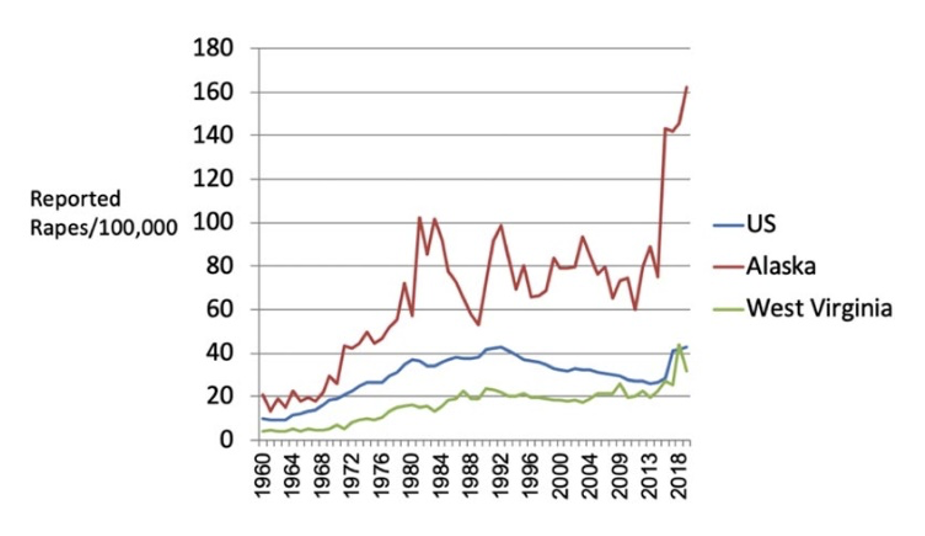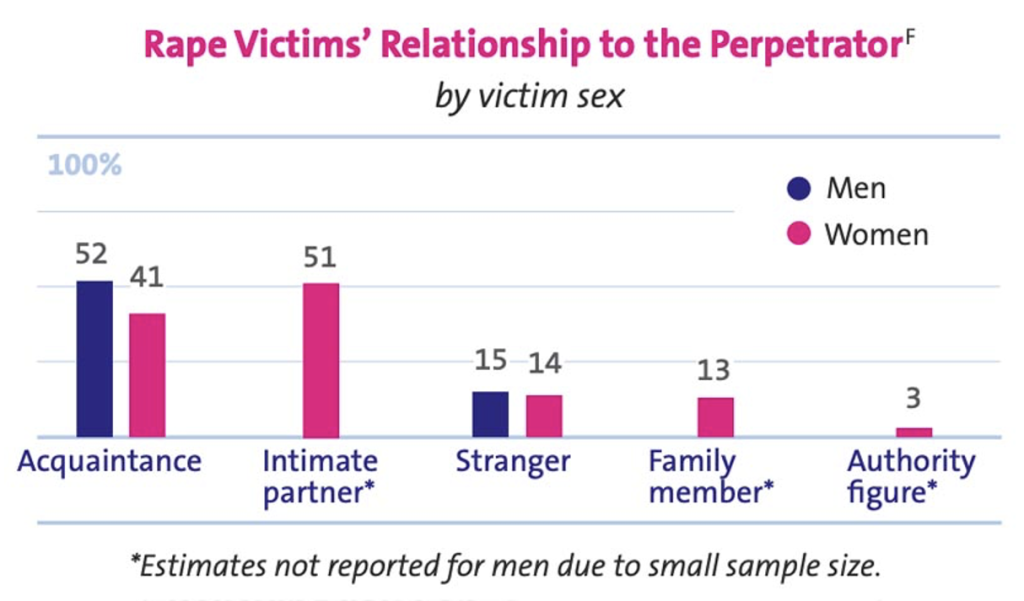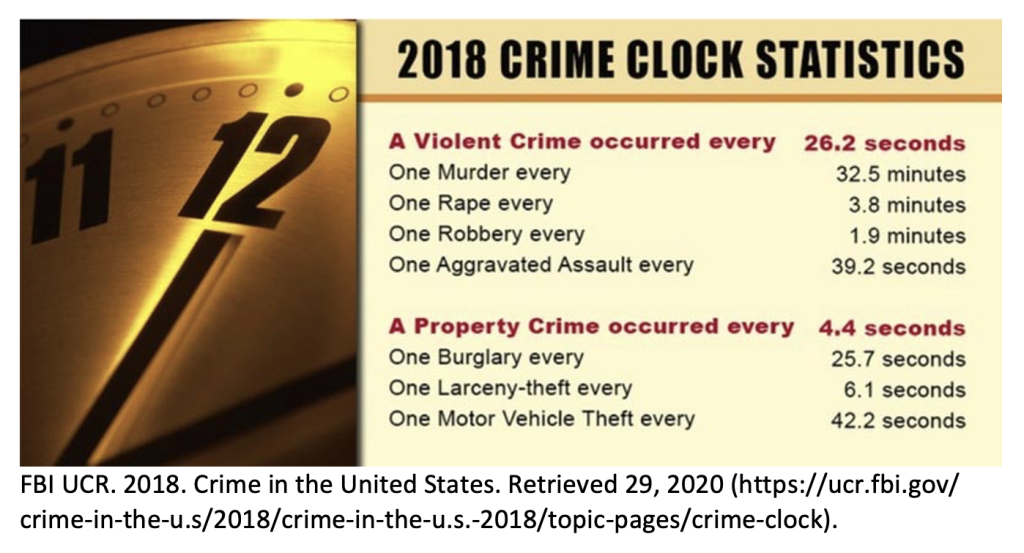6.3 Rape & Sexual Assault
Rape is a form of violence perpetrated by individuals, often men, driven by power, anger, selfishness, and sadistic tendencies. It is a highly dangerous and destructive act. The rate of rape in a population can be measured as the number of reported rapes per 100,000 females in that population during a given year. According to data from 2019, the United States ranked 14th in terms of rape rates globally, with 13 other countries reporting higher rates.
Countries such as South Africa, Botswana, Lesotho, Swaziland, Bermuda, and Sweden had higher rape rates than the United States, with South Africa having the highest rate at 132.4 reported rapes per 100,000 women. This means that approximately 13 out of every 100 women were reported as victims of rape in South Africa in that year. Research conducted by the United Nations Surveys on Crime Trends and the Operations of Criminal Justice Systems consistently identifies South Africa as the most dangerous nation globally, especially regarding crimes such as rape.
Figure 6.2 depicts in the United States, rape occurs frequently, and the country’s rape rate places it among many other nations with high incidences of rape. The Federal Bureau of Investigation (FBI) compiles statistics on violent crimes reported to local police, although unreported crimes cannot be included. These statistics are summarized in reports available on government websites. Alaska has the highest rape rate among the states, while West Virginia is among the safest. Despite fluctuations over the years, rape rates in the U.S., including Alaska and West Virginia, have not returned to the lower levels seen in 1960. The reasons behind the high rape rates in the U.S., particularly in Alaska, are complex and have been extensively studied, involving religious, political, and sociological factors. Exploring this issue from a sociological perspective offers new insights into understanding and addressing this challenge.
Figure 6.2. Reported Rapes per 100,000 Population in United States, 1960-2018

Source: Hammond, Ron, Paul Cheney, Raewyn Pearsey. 2021. Sociology of the Family. Ron J. Hammond & Paul W. Cheney. Retrieved April 2, 2024 (https://freesociologybooks.com/Sociology_Of_The_Family/09_Marriage_and_Other_Long-Term_Relationships.php).
The National Sexual Violence Resource Center (NSVRC) is dedicated to preventing sexual violence and supporting individuals affected by it. They gather information from various sources, including the Bureau of Justice Statistics’ annual National Crime Victimization Surveys (NCVS), to provide insights into addressing sexual violence. According to NSVRC’s analysis of the 2015 and 2018 NCVS data, approximately 1 in 5 women in the United States (21.3% or an estimated 25.5 million) reported experiencing completed or attempted rape at some point in their lives. This includes instances of forced penetration, attempted forced penetration, or penetration facilitated by alcohol or drugs. Additionally, about 2.6% of men in the U.S. (an estimated 2.8 million) reported experiencing completed or attempted rape victimization.
The incidence of self-reported rape or sexual assault more than doubled from 1.4 victimizations per 1,000 persons aged 12 or older in 2017 to 2.7 in 2018. Based on survey data, it is estimated that 734,630 individuals were victims of rape (threatened, attempted, or completed) in the United States in 2018. Despite this increase in self-reporting, there was a decrease in reporting to law enforcement from 2017 to 2018. While 40% of rapes and sexual assaults were reported to police in 2017, only about 25% were reported in 2018 (NSVRC 2024). Additionally, according to data compiled from the National Crime Victimization Survey (NCVS) in 2018, more than half of men and 41% of women who experienced sexual assault knew the person who attacked them (NCVS 2020).
Impact of rape
In this discussion, we’ll explore rape through the lens of C. Wright Mills’ Sociological Imagination, examining it from both personal and broader sociological perspectives. It’s crucial to recognize that the responsibility for rape lies solely with the perpetrator and their individual choices. Rape, as defined, is fundamentally non-consensual. Throughout history, some have wrongly characterized rape as a form of sex. However, it’s essential to distinguish that rape involves no consent, whereas sex involves mutual agreement. Typically, perpetrators use force or threats to coerce compliance.
Figure 6.3. Relationship of Sexual Assault Victim to the Perpetrator

Source: Hammond, Ron, Paul Cheney, Raewyn Pearsey. 2021. Sociology of the Family. Ron J. Hammond & Paul W. Cheney. Retrieved April 2, 2024 (https://freesociologybooks.com/Sociology_Of_The_Family/09_Marriage_and_Other_Long-Term_Relationships.php).
Rapists not only inflict physical harm on their victims but often exacerbate the trauma by verbally blaming them before leaving. This exacerbates the victim’s recovery process, as many already struggle with self-blame. Research by Ullman et al. (2007) delves into the construct of self-blame and offers a model to aid survivors in their recovery. Additionally, studies like Murnen et al. (1989) have shown that many college students who are victims of rape tend to blame themselves.
It’s unfortunate that many victims internalize blame, often expressing sentiments like “I should have…” as they navigate through grief and recovery. However, it’s crucial for individuals within their support networks to refrain from adding to this burden with intentional or unintentional blame. Just as you wouldn’t blame a mugging victim for walking down the street alone, it’s essential not to blame rape victims for the violence inflicted upon them. Unfortunately, defense attorneys and media reports sometimes contribute to victim-blaming narratives, while the families and friends of rape victims may also grapple with feelings of self-blame.
It’s essential to recognize that violence can happen to anyone, regardless of their moral character. The notion that only good things happen to good people, known as “Just World Syndrome,” is a myth worth examining. Ultimately, violence affects individuals irrespective of their moral standing, and it’s vital to provide support and empathy to survivors rather than adding to their burden of blame.
On a broader social scale, we can gain insights into rape through scientific research, analysis of crime data, and interviews with perpetrators. By studying these factors, we can identify trends in the behavior of rapists and understand the underlying reasons for their actions. This knowledge helps us address the issue of rape at various levels of social intervention.
When considering the high rates of rape in the United States, several possible explanations emerge based on over three decades of research:
- The implementation of rape prevention programs and the establishment of rape crisis centers have made it easier for victims to report incidents of rape and seek assistance. In the past, many incidents may have gone unreported due to the lack of accessible support services.
- There has been an increase in substance use among both perpetrators and victims, which is closely linked to reduced inhibitions in men who might not otherwise engage in violent behavior towards women.
- During the 1960s, 1970s, and 1980s, there was a cultural shift towards sexual promiscuity, moving away from abstinence. This shift may have contributed to a sense of entitlement among men regarding their sexual desires. Additionally, changes in societal values and expectations concerning masculinity, femininity, and sexual behavior may have played a role in shaping attitudes towards sexual predation.
Many rapists express feelings of victimization when they face arrest and accountability, with over six out of ten rapists in the US not facing prison time or guilty verdicts. These individuals often deny any wrongdoing and pose a danger to both themselves and society. Their actions disrupt the lives of others and demonstrate a focus on self-individualism rather than considering the well-being of the broader community. Moreover, they typically lack feelings of shame or guilt and often believe they are entitled to act without consequences.
Understanding this pattern of behavior is crucial in empowering individuals and communities to prevent and eventually eliminate rape from society. By refraining from committing sexual violence and promoting awareness of these issues, we can work together to create safer communities for everyone.
Rapists often target their victims’ sexual parts as a means of exerting power, dominance, anger, and control. Both the FBI and experts in the field of Criminal Justice recognize that factors such as anger, power, sadism, and even sexual gratification serve as motivations for rapists to commit their attacks (Wikipedia 2024).
Greg Cooper, a former FBI profiler, developed a model categorizing rapists into four types based on their likelihood of harming the victim and their confidence in their use of violence (Hammond et al. 2021). The most common type identified is the power-reassurance rapist. This individual typically employs minimal to no violence during the assault and struggles with a weak sense of self and masculinity. For them, rape serves as a means to exert power, dominance, anger, and control over others. This type of rapist often feels inadequate in various aspects of life and resorts to rape in a misguided attempt to feel adequate.
On the other hand, the power-assertive rapist exhibits a very low self-esteem and seeks to validate masculinity through the act of rape. Although they may use minimal force or violence, their actions are driven by deep-rooted feelings of shame. Despite frequent offending, they fail to derive long-term satisfaction from their assaults.
The next two types of rapists pose greater danger. They typically have a more positive self-image and are prone to using violence. The anger-retaliatory rapist exhibits high levels of self-confidence, often to an excessive degree. They tend to belittle, degrade, humiliate, and punish the victim, even for actions the victim did not commit. For instance, if they had a bad day at work, they may take out his frustrations on another. This type of rapist is known for being brutal and overwhelming their victims, leaving them with little opportunity to resist. Essentially, they inflict their own life’s problems onto the victim.
The anger-excitation rapist, although less common, is the most malevolent. They derive pleasure from causing pain to others and is willing to torture, kidnap, or even kill the victim for their own gratification. This type of rapist exhibits sadistic and predatory behavior, using their intelligence to meticulously plan and target unsuspecting victims. Greg Cooper has described this type as “evil” and representing “the dark side of humanity.”
The FBI gathers data from police agencies across the United States for its Uniform Crime Report (UCR). Using information from 2018, the FBI also creates an annual Crime Clock (Figure 6.4), which estimates how frequently a specific crime, such as rape, might occur based on previous years’ data. It’s important to note that these estimates are based on reported crimes, not necessarily on the actual number of crimes that occurred. This means that the actual frequency of crimes could potentially be three times higher than what is reported. For example, if one reported rape occurs every 3.8 minutes in the U.S., there’s a strong possibility that two additional rapes, which go unreported, also occur during that same time frame. This would result in a total of three rapes every 3.8 minutes in the United States. In simpler terms, it translates to approximately one rape happening every minute or so.
Figure 6.4. Crime Clock Statistics

Source: Hammond, Ron, Paul Cheney, Raewyn Pearsey. 2021. Sociology of the Family. Ron J. Hammond & Paul W. Cheney. Retrieved April 2, 2024 (https://freesociologybooks.com/Sociology_Of_The_Family/09_Marriage_and_Other_Long-Term_Relationships.php).
The Rape Abuse & Incest National Network (RAINN), which operates as a prominent anti-sexual assault organization in the United States, offers valuable insights into the issue of rape. RAINN also provides support services for those affected by rape through their National Sexual Assault Hotline at 1-800-656-HOPE and an online chat hotline in English and Spanish on their website. Their definition of rape and sexual assault encompasses a wide range of non-legal terms, including sexual assault, rape, and sexual abuse. They emphasize that the legal definitions of these crimes may vary from state to state.
Table 6.2. Ways To Stand Against Rape Culture
-
-
-
-
-
-
- Create a culture of enthusiastic consent.
- Speak out against the root causes
- Redefine masculinity
- Stop victim-blaming
- Have zero tolerance
- Broaden your understanding of rape culture
- Take an intersectional approach
- Know the history of rape culture
- Invest in women
- Listen to survivors
- Don’t laugh at rape
- Get involved
- End impunity
- Be an active bystander
- Educate the next generation
- Start—or join—the conversation
-
-
-
-
-
United Nations. 2019. “16 ways you can stand against rape culture” Retrieved July 27, 2020 (https://www.unwomen.org/en/news/stories/2019/11/compilation-ways-you-can-stand-against-rape-culture).
Source: Hammond, Ron, Paul Cheney, Raewyn Pearsey. 2021. Sociology of the Family. Ron J. Hammond & Paul W. Cheney. Retrieved April 2, 2024 (https://freesociologybooks.com/Sociology_Of_The_Family/09_Marriage_and_Other_Long-Term_Relationships.php).
RAINN‘s website provides detailed definitions of various forms of sexual violence, including sexual assault, child sexual abuse, sexual assault of men and boys, intimate partner sexual violence, incest, and drug-facilitated sexual assault. In general, sexual activity is considered non-consensual if the individual is forced, threatened, unconscious, under the influence of drugs, a minor, developmentally disabled, chronically mentally ill, or believes they are undergoing a medical procedure. More information on these definitions can be found on RAINN’s website.
